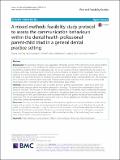Files in this item
A mixed-methods feasibility study protocol to assess the communication behaviours within the dental health professional-parent-child triad in a general dental practice setting
Item metadata
| dc.contributor.author | Yuan, Siyang | |
| dc.contributor.author | Humphris, Gerry | |
| dc.contributor.author | Ross, Al | |
| dc.contributor.author | MacPherson, Lorna | |
| dc.contributor.author | Zhou, Yuefang | |
| dc.contributor.author | Freeman, Ruth | |
| dc.date.accessioned | 2018-08-13T12:30:06Z | |
| dc.date.available | 2018-08-13T12:30:06Z | |
| dc.date.issued | 2018-08-13 | |
| dc.identifier | 255271897 | |
| dc.identifier | 15fb6647-8d5f-4f83-bddc-2073136cc11d | |
| dc.identifier | 85072769401 | |
| dc.identifier.citation | Yuan , S , Humphris , G , Ross , A , MacPherson , L , Zhou , Y & Freeman , R 2018 , ' A mixed-methods feasibility study protocol to assess the communication behaviours within the dental health professional-parent-child triad in a general dental practice setting ' , Pilot and Feasibility Studies , vol. 4 , 136 . https://doi.org/10.1186/s40814-018-0331-3 | en |
| dc.identifier.issn | 2055-5784 | |
| dc.identifier.other | RIS: urn:EE39AAEF1DF4763A0C28FF231E8040EC | |
| dc.identifier.other | RIS: Yuan2018 | |
| dc.identifier.other | ORCID: /0000-0002-4601-8834/work/64033945 | |
| dc.identifier.uri | https://hdl.handle.net/10023/15813 | |
| dc.description | This research is funded by Childsmile Programme. | en |
| dc.description.abstract | Background : The promotion of twice yearly application of fluoride varnish (FVA) to the teeth of pre-school children in the dental practice is one component of Scotland’s child oral health improvement programme (Childsmile). Nevertheless, evidence shows that application rates of FVA are variable and below optimal levels. The reasons are complex, with many contextual factors influencing activity. However, we propose that one possible reason may be related to the communication challenges when interacting with younger children. Therefore, the primary aim of the study is to assess the feasibility of conducting a video observational study in primary dental care. The secondary aim is to assess the communication behaviours of dental professionals and those of the parents to predict child cooperation when receiving FVA using this video observational study design. Methods: Approximately 50 eligible pairs of parents and child patients aged between 2 years and 5 years from general dental practices will be recruited to participate in the study. The consecutive mixed-method study will consist of two parts. The first part will be cross-sectional observations of the dental health professional-child-parent communication during dental appointments conducted in the general dental practice setting, using video recording. The second part will be a post-observation, semi-structured interview with parents and dental health professionals respectively. This will be implemented to explore their views on the acceptability and feasibility of being observed using video cameras during treatment provision. Discussion: The mixed-methods study will allow for directly observing the communication behaviours in the clinical setting and uncovering the views of participating dental health professionals and parents. Therefore, the study will enable us to [i] explore new ways to study the nature of triadic interaction of dental health professional-child-parent, [ii] identify dental health professionals’ effective communication behaviours that promote child patient and parent’s experience of using preventive dental service and [iii] to assess the feasibility of the study through uncovering the views of dental health professionals and parents. | |
| dc.format.extent | 9 | |
| dc.format.extent | 789656 | |
| dc.language.iso | eng | |
| dc.relation.ispartof | Pilot and Feasibility Studies | en |
| dc.subject | Triadic behaviour coding scheme | en |
| dc.subject | Children | en |
| dc.subject | Communication | en |
| dc.subject | Dental care | en |
| dc.subject | Video observation | en |
| dc.subject | RK Dentistry | en |
| dc.subject | T-NDAS | en |
| dc.subject.lcc | RK | en |
| dc.title | A mixed-methods feasibility study protocol to assess the communication behaviours within the dental health professional-parent-child triad in a general dental practice setting | en |
| dc.type | Journal article | en |
| dc.contributor.institution | University of St Andrews. Population and Behavioural Science Division | en |
| dc.contributor.institution | University of St Andrews. WHO Collaborating Centre for International Child & Adolescent Health Policy | en |
| dc.contributor.institution | University of St Andrews. Health Psychology | en |
| dc.contributor.institution | University of St Andrews. St Andrews Sustainability Institute | en |
| dc.contributor.institution | University of St Andrews. School of Medicine | en |
| dc.identifier.doi | https://doi.org/10.1186/s40814-018-0331-3 | |
| dc.description.status | Peer reviewed | en |
This item appears in the following Collection(s)
Items in the St Andrews Research Repository are protected by copyright, with all rights reserved, unless otherwise indicated.

